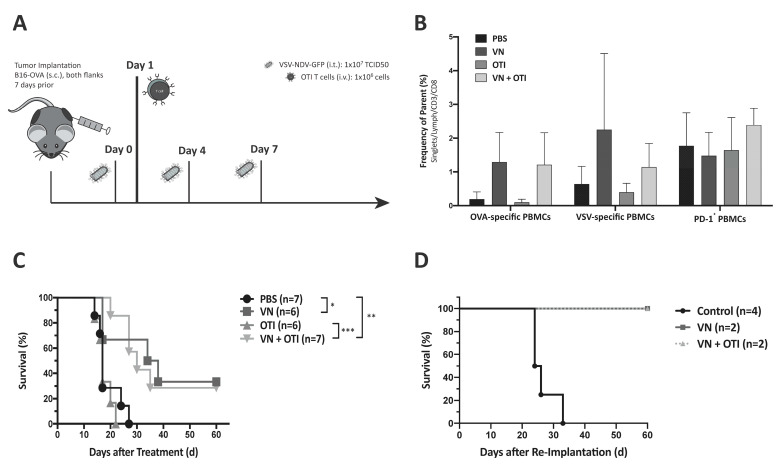Figure 3.
VSV-NDV and combination therapy improve survival in murine melanoma model. (A) Experimental set-up of the survival experiment. C57BL6/J mice were implanted with 2.4 × 105 (injected tumor) and 1.2 × 105 (uninjected tumor) B16-OVA cells subcutaneously on contralateral flanks. One week later, the mice were randomly distributed into treatment groups (n = 6–7) and injected intratumorally with VSV-NDV (VN) at a dose of 107 TCID50 or PBS in an equal volume of 50 μL on day 0, followed by an intravenous OTI T cell injection (1 × 106) on day 1 for combination treatment or OTI monotherapy. Intratumoral virus or PBS injections were repeated on day 4 and 7. (B) Blood was collected on day 16 after the first treatment to analyze the systemic expansion of OVA- and VSV-specific CD8+ T cells via tetramer staining as well as PD1 expression patterns by flow cytometry. (C) Survival of the different treatment groups was monitored and plotted in a Kaplan–Meyer curve. Statistical significance was determined by log-rank test (* p < 0.05, ** p < 0.01, *** p < 0.001). (D) Long-term surviving mice treated with VSV-NDV or combination therapy (VN + OTI) (N = 2) were subjected to rechallenge with subcutaneous implantation of 1.2 × 105 B16-OVA cells in a 100 µl volume. Previously untreated age- and sex-matched C57BL6/J mice were similarly implanted with B16-OVA cells as a control. Survival was monitored and plotted in a Kaplan–Meier curve.

